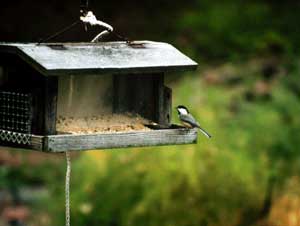Winter Feeding
Wintertime feeding is critical to the long-term survival of your local songbird population. A conscientious feeding program in the winter will reduce the number of deaths from starvation, thirst, and dehydration. A dependable supply of food and water also encourages visiting birds to take up residence as couples in the spring to start families. They will be your first line of defense against pest insects which will start to hatch as winter wanes.
In cold weather birds need foods high in fats. Small birds such as chickadees burn enormous numbers of calories to keep warm. Expect to fill feeders more often and add suet, peanut butter and kitchen fats to the menu regularly. Stale piecrust and donuts also provide fat.
Spring Feeding
Early spring is the time for courting. It is also the time when natural food supplies are lowest. All the insect eggs, berries, acorns and pinecones have been eaten and your plants have not yet produced new growth to replace them. Keep bird feeders filled even though there is no longer any frost. Spring feeder offerings also attract birds migrating northward, and a glimpse of birds not normally seen.
 |
The birds that regularly visit your feeder are likely to settle down and build nests nearby. When their eggs hatch, the babies are all stomach, so parents appreciate a convenient food source for themselves to fuel their incessant hunt for insects, eggs and caterpillars for the nestlings. As spring progresses and other food sources develop in the yard, begin to reduce the supply of bird food in the feeders. By late spring, you might fill the feeder only once a week to give the birds a supplemental snack.
Summer Feeding
Many bird species, such as wrens and finches, have more than one brood over the season. So, as they continue to spend parts of the summer finding food for nestlings, a supplementary food supply at the local feeder is most welcome.
While the first brood benefits from a large spring supply of insects and caterpillars, later hatchlings may be shortchanged. Young birds need a high protein diet because they must grow and develop feathers in a short period of time. A source of calcium, such as crushed eggshells, is valuable too. Summer feeding also ensures a larger flock of birds in your yard for next year to keep destructive insect pests at bay.
Fall Feeding
Filling feeders in the fall reminds the local birds that they have a reliable food source, even though they have a rich supply of seeds on plants during this season. The feeder also assists any migrating birds that happen by, replenishing their energy for the next day’s flight to southward.
Increase the volume of food in your feeders as hard frost arrives and the temperatures start to drop. As cold weather closes in, be sure to provide a filled suet cage to supply highly nutritious fat that birds can’t always get in the wild at this time.

